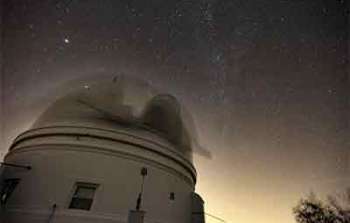sci17002 — Announcement
Zwicky Transient Facility Community Workshop
January 31, 2017
Steve Ridgway (NOAO), ZTF Community Science Advisory Committee Chair
Scientists from the Zwicky Transient Facility (ZTF), the ZTF Community Science Advisory Committee (CSAC), and interested members of the astronomical community met at an AAS splinter meeting to discuss the public surveys to be carried out with ZTF. Science objectives for ZTF include ultraluminous supernovae, the early detection of supernovae, stellar variability of all kinds (especially interacting binaries, flaring, and stellar rotation), tidal disruption events, discovery of Near-Earth Objects, asteroid rotation curves, comet activity, and serendipity. The splinter meeting was carried out in workshop format, with approximately half of the time devoted to a wide-ranging discussion of ZTF and community interests and concerns.
What is ZTF? An upgrade of the Palomar Schmidt, ZTF is equipped with a large CCD array that covers 47 square degrees and surveys the sky in g and r. The survey instrumentation and strategy are designed for variable and transient science. Forty percent of the survey time will be dedicated to a public survey and the remainder to “private” surveys for ZTF consortium members. All data will be processed through a single pipeline. Public data will be released as soon as they are archived, and all “private” data will be available through the same archive but with a delay.
Community Survey. ZTF commissioning is expected to start in November 2017, with the community survey to begin immediately after commissioning, approximately 1 year from now. Data release will begin as early as possible in the first year. Nightly transient alerts will begin as soon as possible (following the training of algorithms for automated control of false positives). The aggressive data release schedule, as well as a number of other planned enhancements to the data system, are dependent on further fund raising.
As described by Principal Investigator Shri Kulkarni and Project Scientist Eric Bellm, the community survey will be carried out as g/r image pairs, with the two images separated in time by about 1 hour in order to confirm variability and to detect the motion of solar system bodies. The Galactic plane will be imaged in g and r every night, and the full sky will be imaged in g and r every 3 nights.
While it was clear from the discussion that no cadence will please all potential users equally, all should know that experiments with other cadences will be carried out during the first year of operations, and after the first year, ZTF and the CSAC will engage the community in discussing the survey strategy for the second and third survey years.
Transient Alerts. ZTF will provide transient alert data packets that emulate as much as possible the planned LSST alerts. However, support for correlation with other databases and user filters will be needed. An external “event-broker” process will be highly desirable. The NOAO/UA ANTARES broker group is exploring deployment of ANTARES on the ZTF alert stream as a high-impact community science-enabling opportunity and an important pre-LSST test of the system.
Community Coordination. There was discussion at the workshop of possible coordination in the community to take advantage of the ZTF opportunity. While the supernova community is well organized, those interested in other topics might consider forming similar science interest groups. Strategies developed to work with ZTF could be expected to roll over naturally into the LSST era.
Additional Resources. ZTF is a follow-on to the PTF and iPTF surveys, which produced more than 4M images, now available interactively and via API as one of the largest datasets at IPAC, including 600M objects with light curves. Details are available at http://www.ptf.caltech.edu/page/data_access
Further information on the facility and surveys is available at the ZTF web site. The presentations from AAS splinter session are available at: http://www.ptf.caltech.edu/page/ztf_workshop_aas229
ZTF will be among the topics of discussion at the NOAO/Las Cumbres Observatory (LCOGT) conference “Building the Infrastructure for Time-Domain Alert Science in the LSST Era”, to be held in Tucson 22-25 May 2017. This meeting is particularly timely, as proposals to use community access to LCOGT for ZTF follow-up early in the first year of the survey will be due to the NOAO TAC in the fall of 2017.
ZTF and the CSAC tentatively plan to organize another community forum shortly after commissioning data becomes available, possibly as soon as the January 2018 AAS.
(An earlier version of this story referred to Las Cumbres Observatory by the acronym LCO. This has been updated to LCOGT to avoid confusion with Las Campanas Observatory.)
About the Announcement
| Id: |
ID
sci17002
|

